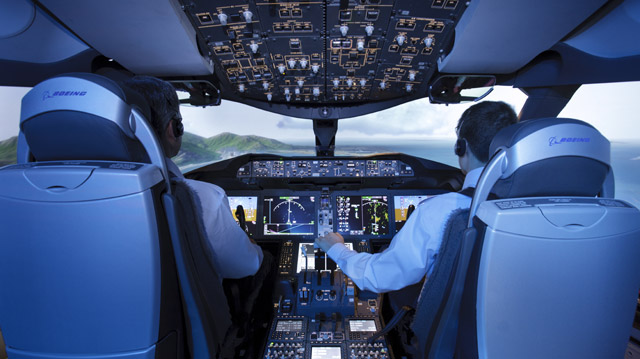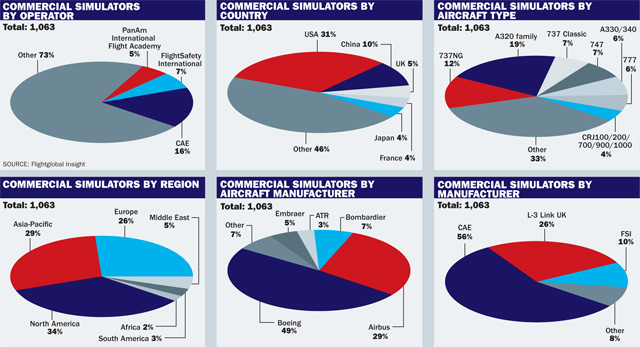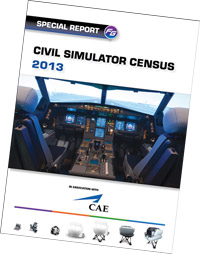The supply side of the civil aviation flight simulator market is increasingly crowded and commoditised, which should lead to lower prices for airlines and other buyers of full-flight simulators (FFSs). Vendors who are capable of producing high-end Level D FFSs number in the double digits, none of whom are Chinese, and three major aerospace conglomerates are beginning to aggressively compete aggressively for a piece of the action.
The openly competitive Level D FFS market, though trending slightly upward, sees transactions that average only 40-50 simulators per year. In recent years, the market has been dominated by Montreal, Canada-based CAE, which has been selling units numbering in the mid- to high-20s annually directly to airlines or third-party lessors plus several units to its joint venture training centres.
 |
|---|
CAE CAE continues to dominate the market for FFS with a 56% share of the installed base |
However, in the last year and a half, Lockheed Martin, L-3 Communications and Rockwell Collins have dived into the civil flight simulator pool. And there are non-traditional upstarts entering the market, such as Venyo, a Belgian IT company which made its debut at the Paris Airshow last month.
PROCUREMENT DECISIONS
"Fifteen years ago, simulator procurement decisions were made more on the technical merits of the proposals. Today, decisions are made almost exclusively on price," says John Van Maren, director of programmes and customer support at Flightsafety International (FSI), one of the three main suppliers.
The selling price of an FFS ranges from about $8-10 million for that of a narrowbody aircraft to $15-20 million for those of widebodies, which also tend to require more customisation based on buyer preference. So can 10 manufacturers split an annual gross market turnover of $500-700 million and maintain the type of profit margins that will satisfy investors?
Rockwell Collins was banking on its aircraft avionics relationships to provide it an inside track for simulator contracts when it acquired the components business for simulator production. Within the 2003-10 timeframe, the US company bought simulator integrator NLX, Evans & Sutherland's image generator business, SEOS Displays and Blue Ridge Simulation. Yet Rockwell Collins was almost invisible in the marketplace until recently.
"As the industry knows, we struggled. It was a tough time to enter the market. We pulled back on the reins a bit," says LeeAnn Ridgeway, vice president and general manager of simulation and training solutions. Over the last two years, Ridgeway has led an assessment of the future of the market and honed in on China.
In April, Rockwell Collins signaled it thought the time was right to re-engage. It announced a joint venture with a subsidiary of Aviation Industry Corporation of China (AVIC), Beijing Bluesky Aviation Technology. Based in Wuxi, Jiangsu Province, the JV will produce FFSs, initially for airlines and aircraft manufacturers in China, but eventually also for the global market. Rockwell and Bluesky previously collaborated on simulators for the MA60, MA600 and C919 programs.
Is Rockwell Collins not concerned about helping China develop indigenous flight simulation capability and eventually having it compete on the world stage with Western companies? Ridgeway believes the "tight coupling" of Rockwell's aircraft avionics business will be critical to training concurrency and that global marketing will depend heavily on the Rockwell Collins brand. The company is licensing its simulation architecture to its Chinese partner "but maintaining intellectual property control".
ACQUISITIONS
New York-based L-3 Communications, a multi-faceted aerospace electronics holding company, paid $130 million cash last August for the civil training and simulation business of Thales. Now named L-3 Link Simulation & Training UK, the Crawley operation represents the remnants of Rediffusion Simulation and the Miles subsidiary of Singer-Link, which dominated the simulation business in the 1980s. L-3's Arlington, Texas-headquartered Link Simulation & Training also traces its roots to the American arms of Rediffusion and Singer-Link.
 |
|---|
CAE CAE announced tatal FFS sales of 35 for the fiscal year ended in March |
L-3 / Link has been a strong player in the military simulation market, particularly in relation to Lockheed Martin F-16 trainers and the US Army's Flight School XXI helicopter academy. Under Thales, the civil simulation business had languished due to an apparent lack of corporate support, but L-3 appears to be serious about re-asserting the Link brand in the airline sector. It has added a RealitySeven A330 FFS to its Asian Aviation Training Centre in Bangkok, Thailand, which is expected to be Level D qualified later this year. It opened a support centre in Beijing to service such customers as Boeing Shanghai Aviation Flight Training and Shanghai Eastern Flight Training, plus Hainan, Shenzhen, Sichuan, and Spring Airlines. In addition, Link is building a third A320 FFS for Sichuan Airlines and two A320 FFSs for Spring. Other recent FFS sales deployments include a British Airways Airbus A380-800 unit and a Boeing 777-300ER unit for Japan's All Nippon Airways.
Lockheed Martin, which does not seem to need the revenue or technology from airline simulation, had nonetheless acquired Sassenheim, Netherlands manufacturer Sim-Industries in November 2011 when current chief executive Marilyn Hewson was running Lockheed's electronics unit. The Dutch company, launched in 2004, initially focused on A320 and 737 models but recently added widebody capabilities and won a two-FFS 767 contract from long-time CAE customer, FedEx, considered a benchmark training operator in the industry.
Its business model to date has focussed on leveraging partnerships rather than outright sales. In the last couple of years, Lockheed / Sim-Industries has launched airline training centres in South Korea, Sri Lanka, Indonesia, India, and Brazil. Sim-Industries is also providing an A320 to ST Aerospace Academy - which operates at Singapore's Seletar Airport and Ballarat Airport in Victoria, Australia - for Multi-crew Pilot Licence (MPL) cadet training.
This is not Lockheed's first time at the commercial simulation dance. It opened a US $100 million narrowbody training centre in Orlando, Florida twelve years ago but sold it subsequently.
SALES LOCK-DOWN
CAE announced total FFS sales of 35 for its fiscal year ended in March and in the previous year, nearly tied its record high of 37. Some of those are 'half-sales' to type-rating training centres it operates with China Southern Airlines, AirAsia, Cebu Pacific, Emirates, Iberia, Alitalia, and the merged TAM-LAN in South America. It has enjoyed a near lockdown on sales to Chinese airlines - one year scoring a perfect 10 for 10 - that included China Eastern and its Shanghai Eastern training subsidiary, Air China, Sichuan, and prototype FFSs for the new ARJ21 regional aircraft from Comac. CAE recently opened a second simulator spares depot at Pudong Airport Free Trade Zone in Shanghai to support its 80-plus operational FFSs in the country.
The company is also trying the co-design route in China for Comac's C919 as well as the AVIC medium-sized transport commercial aircraft. These efforts include use of CAE's Augmented Engineering Environment (AEE) toolkit, which uses simulation to help de-risk and abbreviate aircraft development. The AEE's first application is on Bombardier's CSeries, which is in development.
At the same time as it is facing increasing competition, CAE is undergoing significant internal change as well. Jeff Roberts, who led the civil simulator and training centre businesses in one fashion or another for the past decade, has exited the company. Roberts' surprise departure was announced on 6 June. He is replaced as civil group president by Nick Leontidis, a 25-year CAE veteran, originally a software engineer, who has been the point man on the company's highly successful simulator sales efforts in China. He was also the executive leader who oversaw CAE's push into medical simulation and the global mining businesses.
CAE's Montreal-based nemesis, Mechtronix, seems to have regained its financial footing with a reorganisation effort last year. It delivered a Level D 737NG FFS in May to SIM Aerotraining in Paris, and was selected by Boeing to provide a 737NG trainer for its Singapore training centre. It also has a 10-year relationship with the Civil Aviation Flight University of China (CAFUC) encompassing 25 training devices, the latest being a Cessna Citation CJ1 Full Flight Simulator. Last winter, Japanese low-cost carrier Starflyer inaugurated its new flight training center with a Mechtronix A320 FFS.
REGIONAL MARKET
Flightsafety International (FSI), owned by legendary investor Warren Buffett's Berkshire Hathaway, is strong in the regional airline and business aviation training markets, building the majority of its simulators for internal use. It does, however, compete with CAE and others on the open market, and has booked orders in recent months in China (an A320 FFS for Wisesoft Corporate, Chengdu, to train Tibet Airlines pilots), Europe (an Embraer 170/190 for Flybe Training Academy, Exeter, UK), and North America (an Embraer 190 for Aeromexico).
Florida-based Opinicus, which started life as a military simulator upgrade specialist, is preparing to announce a joint venture with Icelandair to provide 757 pilot training in Reykjavik beginning in the fourth quarter of 2014. it has also produced an A300-600 FFS for cargo operator UPS.

At the Paris air show in June, another new player emerged who employed the rare tactic of installing a complete fixed-based simulator on the exhibit floor. Venyo, a Belgian company with an information technology background primarily, demonstrated its 737 simulator which it has been developing for three years and hopes to have certified by next year. The company will not sell simulators outright; instead, Venyo will position its devices near an airline's operations hub and rent out time - a concept referred to as "power by the hour" - on the premise that more than 50% of training cost for some airlines is pilot travel to remote training centres.
Other vendors with Level D full-flight simulator capability include; Axis Flight Training Systems in Graz, Austria and US company Frasca International which is based in Urbana, Illinois, who is best known for lower-end devices but has won a recent order for a Cessna CJ1+ FFS from Nanshan International Flight Academy in Longkou, China.
CIVIL SIMULATOR INDUSTRY AT YOUR FINGER TIPS
Flightglobal's latest Civil Simulator Census - produced in association with CAE - records a total of 1,063 commercial simulators in use in the industry. Of these, 596, or 56%, have been built by CAE; 26% by L-3 Link (formerly Thales); and 10% by FlightSafety International, which specialises in business jets and smaller aircraft.
While these three manufacturers are pre-eminent on the equipment side, the marketplace in terms of operators is much more fragmented and - with a plethora of business models from joint ventures with airlines, wet lease arrangements and outright ownership - difficult to define. According to proprietary figures, CAE is again the biggest individual player with a 16% share of the training market, followed by FlightSafety International at 7% and PanAm International Flight Academy at 5%. Operators with smaller shares than that make up the remaining 73%.
When it comes to aircraft types, the Airbus A320 and Boeing 737 families - NG and Classic variants combined - dominate with 19% marketshare each. The A330/340, 777 and 747 each have a share of 6% or 7% of the overall simulator marketplace, followed by the Bombardier CRJ range. Other manufacturers' aircraft - including Embraer, ATR and legacy types - comprise the other 48%.
 In terms of where simulators are based, the USA/North America dominates with marketshare figures of 31% and 34% respectively. The rapid rise of the Asia-Pacific aviation market is perhaps reflected in the number of simulators now based there - 307 or 29% of the global market, with a third of them in China. This is ahead of Europe, where 280 machines are situated, or 29% of the market. The UK and France are the most popular locations for Europe. The Middle East, South America and Africa each have single-figure shares.
In terms of where simulators are based, the USA/North America dominates with marketshare figures of 31% and 34% respectively. The rapid rise of the Asia-Pacific aviation market is perhaps reflected in the number of simulators now based there - 307 or 29% of the global market, with a third of them in China. This is ahead of Europe, where 280 machines are situated, or 29% of the market. The UK and France are the most popular locations for Europe. The Middle East, South America and Africa each have single-figure shares.
Source: Flight International
















